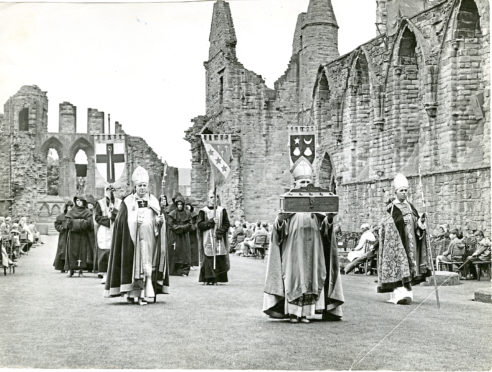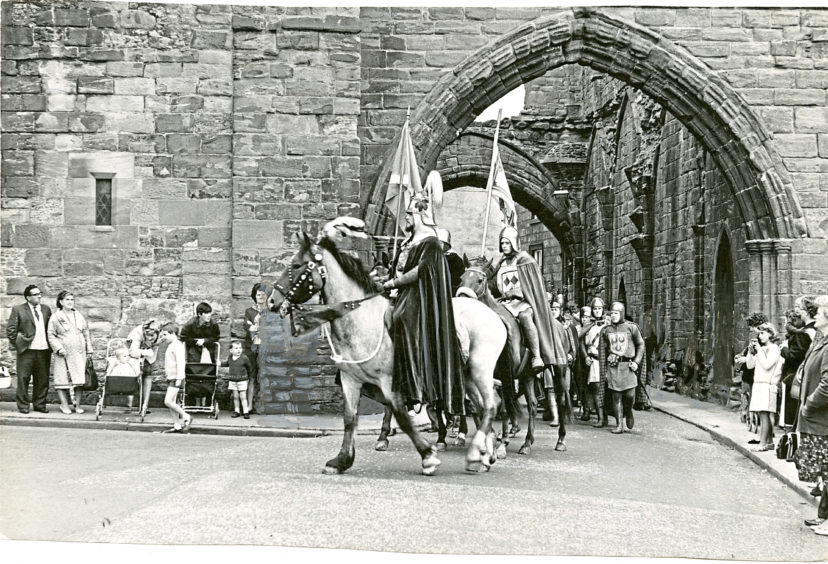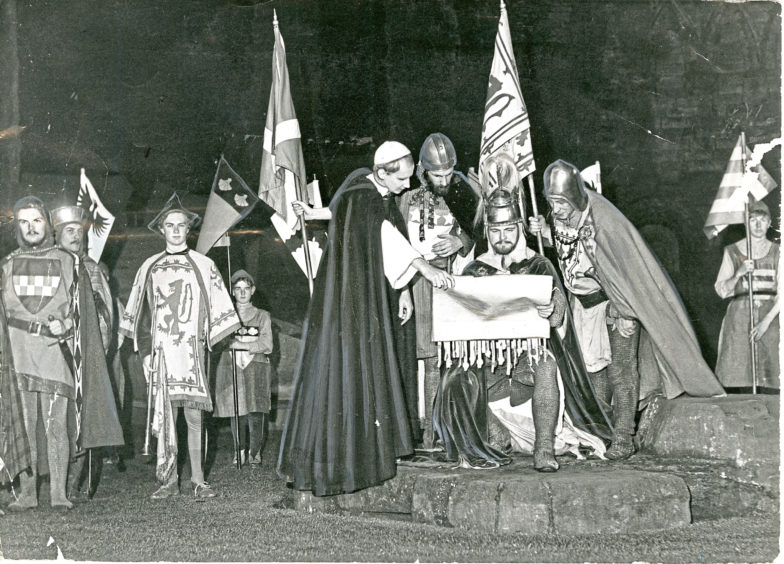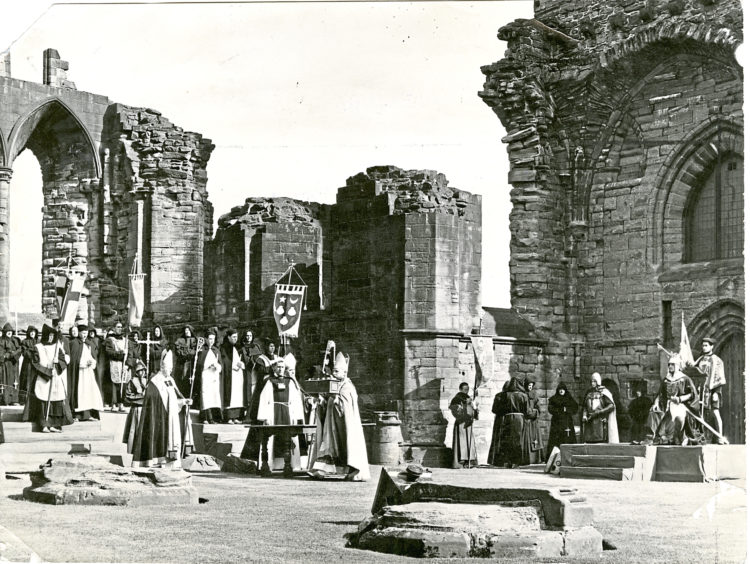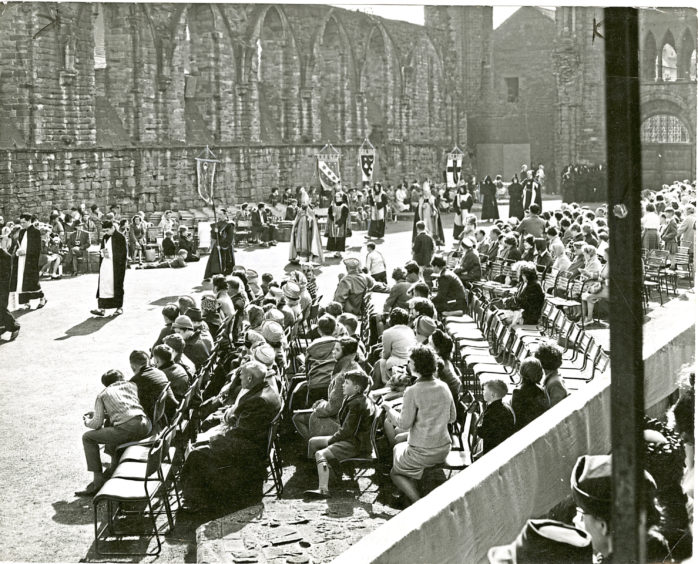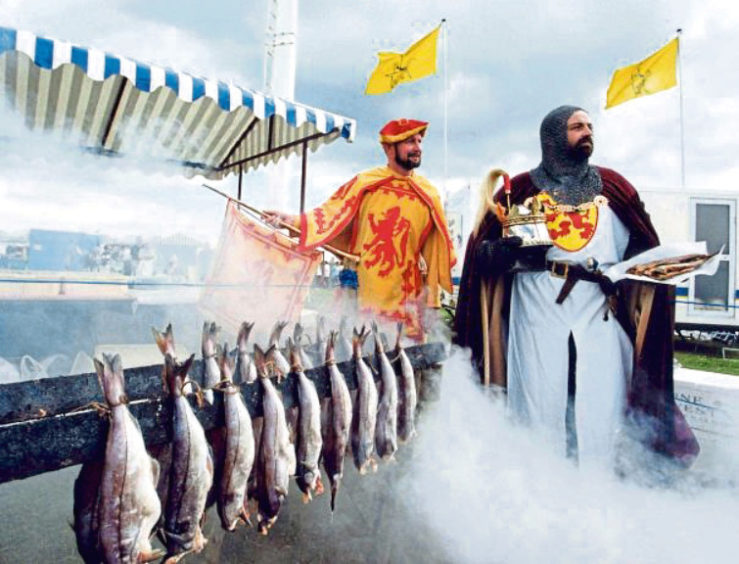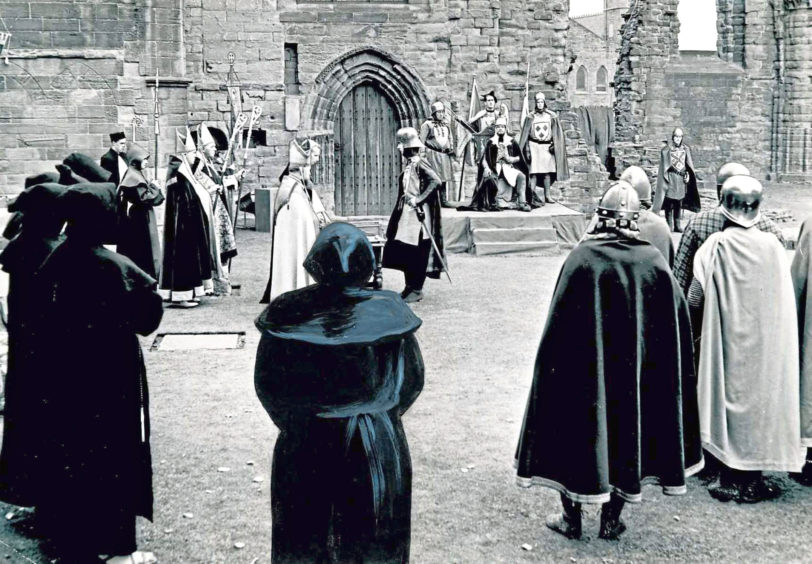The anniversary of The Declaration of Arbroath has been marked with pageants in the Angus town since 1947. Gayle Ritchie chats to Anita Walker of the Arbroath Abbey Pageant Society…
Community figures in colourful 14th century costume, chain mail, swords, horses, lights and music – it was a spectacle unlike any other.
Since 1947, members of the Arbroath Abbey Pageant Society have staged stunning shows enacting the coming into being of the Declaration of Scottish Independence.
The last full performance was in 2005, but a small band of pageant players faithfully come together to play out a pivotal scene from the historic event each year.
The first pageant, in 1947, was run to raise money for the YMCA’s overseas fund. The war may have been over, but many service personnel were still stationed far from home, both in Europe and in unstable outposts of a flagging empire.
Money raised was intended to fund recreational facilities for these troops.
As a sea port and industrial centre, and as the site of a naval air station, the YMCA was also active in Arbroath looking after young male incomers.
For many years, the pageant was held within the abbey ruins and enacted a scene that almost certainly never took place – a great gathering of the barons of Scotland, their king, Robert the Bruce, the Scottish bishops, and the man who for much of the 20th century was the assumed author of the Declaration, Bernard de Linton, the Abbot of the Abbey of Aberbrothock (an alternative name for Arbroath).
Anita Walker, a former president of the Pageant Society, recalls the event as a “colourful and dramatic spectacle which was cleverly produced” and boasting “evocative sound and lighting”.
“It started with an old soldier beyond the high altar telling a story about how we had to fight for freedom,” she muses.
“Men wore chain mail and swords and it was really very rousing. It enacted the arrival of Robert the Bruce at the abbey on his horse, his meeting with Abbot Bernard and a display of the famous document newly sealed.
“People took on the roles of soldiers, monks, barons and courtiers, and we had some fantastic men playing Bruce!
“Before the clerical people arrived, there was a little introductory play, completely imagined, often on the trial of William Wallace before he was taken away in chains. Again, we had some good Wallaces. A male voice choir took on the role of ‘monks’ chanting.”
There are many translations of The Declaration, but the Arbroath Abbey Pageant Society used the Agnes Mure Mackenzie version.
During the annual Pageant Week, performances were done both in daylight and at impressive illuminated evening shows.
The society often took the pageant on tour, round castles and historic properties across Scotland.
Thanks to a lack of funds and volunteers, the huge spectacle has not taken place for 15 years.
But Anita says that every year, a small group of society members meet at the abbey gates on April 6 – the anniversary of the Declaration – to read the special document.
“We do it very quietly – we don’t make a song and dance about it,” she says.
“If anyone is passing, they are welcome to watch, but it’s our own way of marking a special moment in history.
“It’s very sad that we don’t do the pageant on the same scale any more. It used to be a big community thing, full of family members and friends. All my brothers were involved – one played a big part in the 650th anniversary – and my great niece still is. A lot of work went into it.
“The truth is that most young people don’t have The Declaration in their hearts. We saw our abbey as our heritage and as our duty to mark April 6.
“We had our time and I’d say the pageant has had its time. Anyone who has been a part of it will never forget it.”
While Anita never played a role in the pageant – most of the acting was done by men – she played a huge part behind the scenes, selling tickets, taking bookings and supporting the spectacle.
Courier business writer Jim Millar once took on the coveted role of Robert the Bruce.
“The pageant was a real community event that saw people from all walks of life take part,” he recalls. “The clever use of lighting took the audience back to when Arbroath Abbey was at its peak.
“This, combined with a substantial cast in 14th century costume and beautifully delivered script created an atmosphere in the ruined abbey that made the hair on the back of your head stand up and you could hear a pin drop.
“We may not see it again in its traditional form, but as a production combining theatre and history, it very much stands the test of time.”
Tomorrow’s plans for a pageant procession, organised by the Arbroath 2020 Festival – a six month programme of events to mark the 700th anniversary of The Declaration – were cancelled due to the coronavirus outbreak.
A horse-led procession of more than 500 people was to have marched from the abbey to Arbroath Harbour, an atmospheric re-enactment of the Declaration of Arbroath sailing to France in 1320 led by Robert the Bruce.
Artist Mandy McIntosh had worked with the community to create costumes and designs for the procession, resulting in a veritable feast for the eyes.
The festival has been postponed to 2021.
